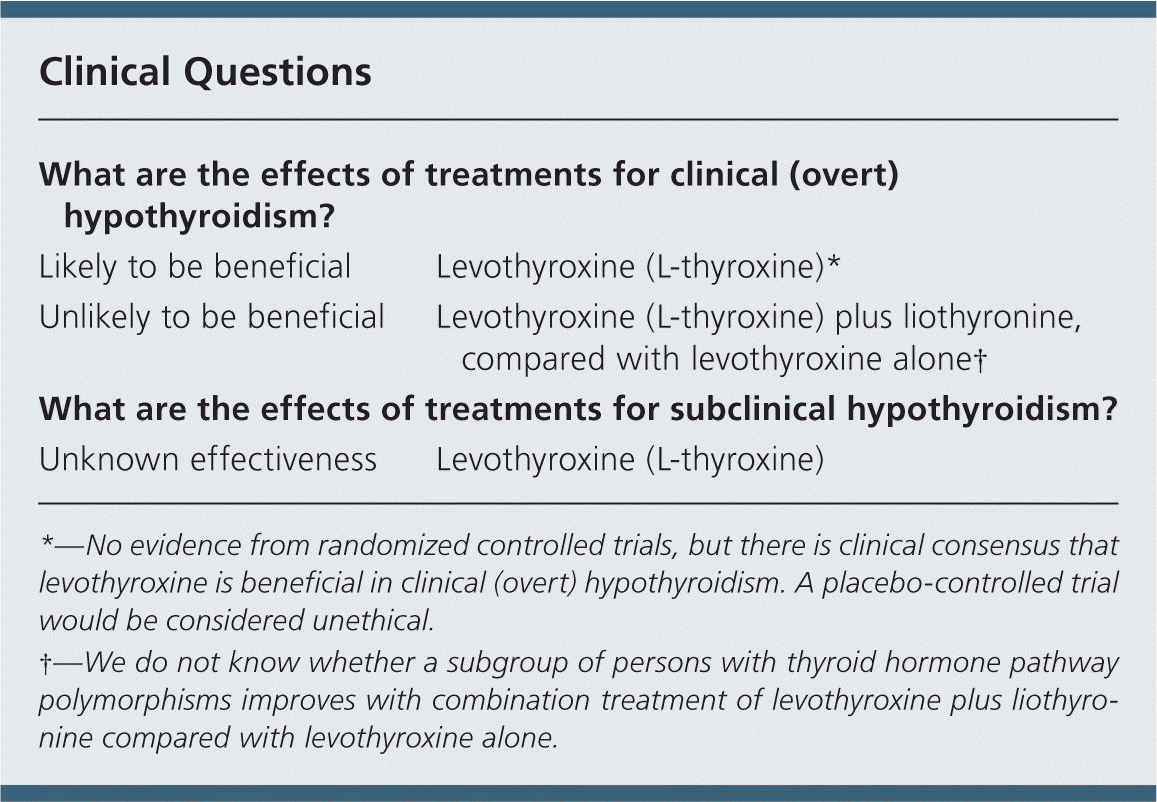
Am Fam Physician. 2015;91(6):359-360
Author disclosure: Birte Nygaard declares that she has received payment from MERCK-Sorono during 2012 as invited speaker on two occasions, and for writing an overview on the topic of the use of L-T4 + L-T3 in the treatment of hypothyroidism.
Primary hypothyroidism is defined as low levels of blood thyroid hormone due to destruction of the thyroid gland. This destruction is usually caused by autoimmunity or an intervention such as surgery, radioiodine, or radiation.
It can be classified as clinical (overt) when diagnosed by characteristic clinical features, raised levels of thyroid-stimulating hormone (TSH), and reduced levels of thyroxine (T4); or subclinical when serum TSH is raised, but serum T4 is normal, and there are no symptoms of thyroid dysfunction.
Hypothyroidism is six times more common in women, affecting up to 40 in 10,000 each year (compared with six in 10,000 men).
There is consensus that levothyroxine is effective in treating clinical (overt) hypothyroidism, but evidence is sparse.
Treatment can lead to hyperthyroidism, reduction of bone mass in postmenopausal women, and increased risk of atrial fibrillation if the person is overtreated.
We found no evidence from randomized controlled trials that levothyroxine plus liothyronine improves symptoms more than levothyroxine alone.
We do not know how effective levothyroxine is in treating persons with subclinical hypothyroidism, as trials have been too small to detect any clinically relevant improvements in outcomes.

| What are the effects of treatments for clinical (overt) hypothyroidism? | |
| Likely to be beneficial | Levothyroxine (L-thyroxine)* |
| Unlikely to be beneficial | Levothyroxine (L-thyroxine) plus liothyronine, compared with levothyroxine alone† |
| What are the effects of treatments for subclinical hypothyroidism? | |
| Unknown effectiveness | Levothyroxine (L-thyroxine) |
Definition
Hypothyroidism is characterized by low levels of blood thyroid hormone. Clinical (overt) hypothyroidism is diagnosed on the basis of characteristic clinical features (e.g., mental slowing, depression, dementia, weight gain, constipation, dry skin, hair loss, cold intolerance, hoarse voice, irregular menstruation, infertility, muscle stiffness and pain, bradycardia, hypercholesterolemia), a serum TSH above the reference range, and T4 (and/or triiodothyronine [T3]) below the reference range. A number of guidelines quote serum TSH of 5 to 10 mU per L as mild hypothyroidism, and greater than 10 mU per L as severe hypothyroidism. Subclinical hypothyroidism is a biochemical diagnosis with findings of a serum TSH above the reference range and serum T4 (and/or T3) within the reference range.
Primary hypothyroidism occurs after destruction of the thyroid gland because of autoimmunity (the most common cause) or medical intervention such as surgery, radioiodine, or radiation. Secondary hypothyroidism occurs after pituitary or hypothalamic damage and is caused by insufficient production due to pituitary or hypothalamic hypofunction. Secondary hypothyroidism is not covered in this review. Euthyroid sick syndrome is diagnosed when T3 levels are low, serum T4 is low, and TSH levels are normal or low. Euthyroid sick syndrome is not covered in this review.
Incidence and Prevalence
Hypothyroidism is more common in women than in men (in the United Kingdom, female-to-male ratio of 6:1). One study (2,779 persons in the United Kingdom with a median age of 58 years) found that the incidence of clinical (overt) hypothyroidism was 40 in 10,000 women per year and six in 10,000 men per year. The prevalence was 9.3% in women and 1.3% in men. In areas with high iodine intake, the incidence of hypothyroidism can be higher than in areas with normal or low iodine intake. In Denmark, where there is moderate iodine insufficiency, the overall incidence of hypothyroidism is 1.4 per 10,000 per year, increasing to eight per 10,000 per year in persons older than 70 years. The incidence of subclinical hypothyroidism increases with age. Up to 10% of women older than 60 years have subclinical hypothyroidism (evaluated from data from the Netherlands and United States).
Etiology and Risk Factors
Primary thyroid gland failure can occur as a result of chronic autoimmune thyroiditis, radioactive iodine treatment, or thyroidectomy. Other causes include drug adverse effects (e.g., amiodarone, lithium), transient hypothyroidism due to silent thyroiditis, subacute thyroiditis, or postnatal thyroiditis.
Prognosis
In persons with subclinical hypothyroidism, the risk of developing clinical (overt) hypothyroidism is described in the UK Whickham survey (25 years of follow-up). For women, the odds ratio (OR) was 8 (95% confidence interval [CI], 3 to 20); for men, the OR was 44 (95% CI, 19 to 104). If both a raised TSH level and antithyroid antibodies were present, the OR for women was 38 (95% CI, 22 to 65), and the OR for men was 173 (95% CI, 81 to 370). For women, the survey found an annual risk of 4.3% per year (if both raised serum TSH levels and antithyroid antibodies were present) and 2.6% per year (if a raised serum TSH level was present alone); the minimum number of persons with raised TSH levels and antithyroid antibodies who would need treatment to prevent this progression to clinical (overt) hypothyroidism in one person over five years is five to eight.
A large cross-sectional study (25,862 persons with serum TSH between 5.1 and 10.0 mU per L) found significantly higher mean total cholesterol concentrations in persons who were hypothyroid compared with persons who were euthyroid (5.8 mmol per L vs. 5.6 mmol per L). Another study (124 older women with subclinical hypothyroidism, 931 women who were euthyroid) found a significantly increased risk of myocardial infarction in women with subclinical hypothyroidism (OR = 2.3; 95% CI, 1.3 to 4.0) and of aortic atherosclerosis (OR = 1.7; 95% CI, 1.1 to 2.6).
Subclinical hypothyroidism is associated with depression. Persons with subclinical hypothyroidism may have depression that is refractory to antidepressant drugs and thyroid hormone alone. Memory impairment, hysteria, anxiety, somatic complaints, and depressive features without depression have been described in persons with subclinical hypothyroidism.
